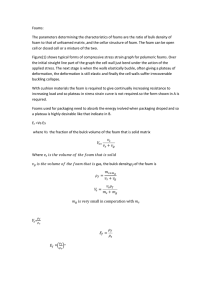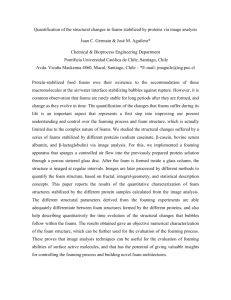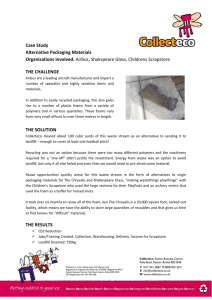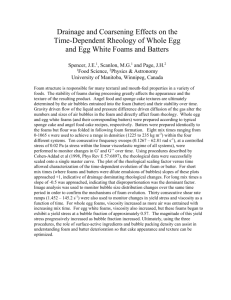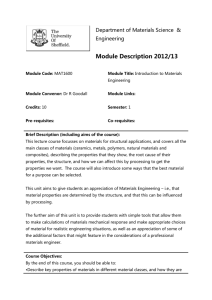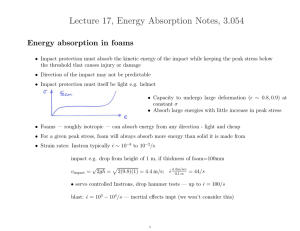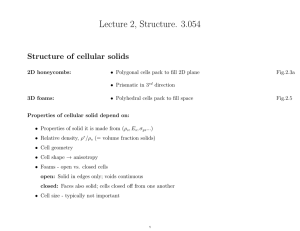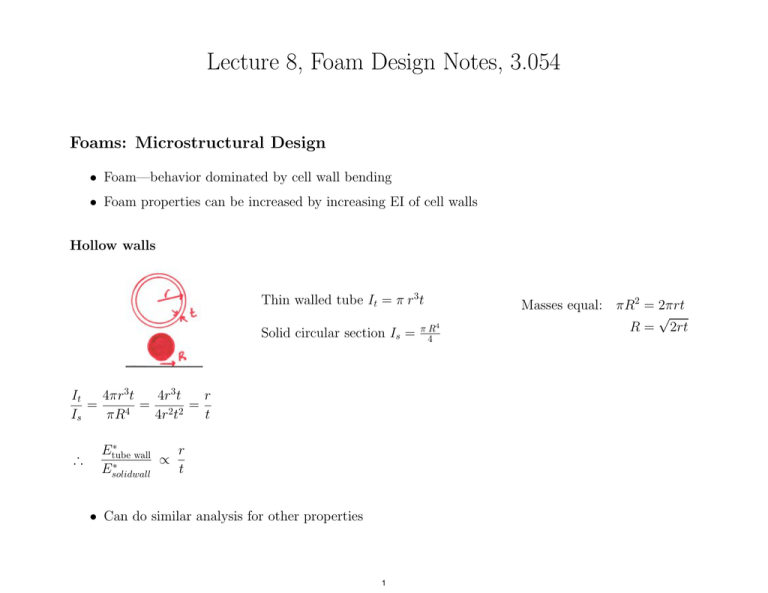
Lecture 8, Foam Design Notes, 3.054
Foams: Microstructural Design
• Foam—behavior dominated by cell wall bending
• Foam properties can be increased by increasing EI of cell walls
Hollow walls
Thin walled tube It = π r3 t
Solid circular section Is =
It
4πr3 t
4r3 t
r
=
= 22=
4
πR
4r t
t
Is
∴
∗
Etube
r
wall
∝
∗
Esolidwall
t
• Can do similar analysis for other properties
1
π R4
4
Masses equal: πR2 = 2πrt
√
R = 2rt
2
Sandwich cell walls
• Sandwich beam — two stiff faces separated by a lightweight core
— core typically a honeycomb or foam (or balsa)
I-beam effect - increase in moment of inertia, with
little increase in weight
Faces — like flanges of I-beam — resist bending
Core — like web of I-beam — resist shear
• Microsandwich foam
Microsandwich foam
• Thin walled hollow spheres distributed in a foam
• Have to get geometry right
• Require:
Spheres: t « D
Esphere » Efoam
Vf sphere ≈ 50 − 60%
Foam: d « c
3
Foams: Microstructural Design
• Another alternative is to use microstructure that induces axial, rather than bending, deformations
• 3D lattice materials: — triangulated trusses in 3D
— Forces in members all axial; bending negligible
• Various processing methods and geometries possible - all triangulated
• Can analyze truss as having pin joints - axial forces in members
• Open-cell structures
σ
F l
Fl
Fl
∝ 2
δ ∝
∝ 2
AEs
t Es
E
l δ
2
∗
F Es t
ρ
t 2
E∗ ∝
∝ Es
∝ Es
l Fl
l
ρs
E ∗ = C Es (ρ∗ /ρs )
C depends on cell geometry and loading direction
E∗ =
• Strength: if struts fail by uniaxial yield :
∗
σpl
= C σys (ρ∗ /ρs )
But some struts in compression - may buckle (generally do buckle)
4
5
Compressive strut buckling
• Elastic buckling σel∗ = CEs (ρ∗ /ρs )2 (like open-cell foam)
• If interaction between elastic buckling and yield — use a reduced modulus
(tangent modulus)
• Also: Imperfections such as non-straight struts or misaligned struts
reduce buckling resistance
“knock-down” factor can be significant ∼ 50%
6
Material Selection
• How to select the best material for same mechanical requirement?
• Section on wood: derived performance index for minimizing mass
of a beam of a given stiffness: E 1/2 /ρ
• Here, discuss material selection more broadly
• Another example: What material minimizes the mass of a beam of a given failure load, Pf ?
Given Pf , span l, square cross-section t2
My
I
Pf l t
∝
∝ σf
t4
σmax =
σmax
t ∝
Pf l
σf
M = maximum moment in beam ∝ P l
y = maximum distance from neutral axis ∝ t
I = moment of inertia ∝ t4
σf = failure stress of beam material
1/3
Mass, m = ρt2 l
m∝ ρ
2/3
Pf l
σf
2/3
l
Performing index: σf /ρ
to be maximized
7
Material Selection
Ashby
bookTables
• Can obtain performance indices for various loading configurations and mechanical requirements
• If plot data for material properties on log-log scales, performance indices appear as straight lines
• Shifting lines up and down identifies best material for that performance index
• Example: modulus-density chart
CMNM
Fig.7.1
E/ρ: axially loaded tie of given stiffness
E 1/2 /ρ: beam of given stiffness
E 1/3 /ρ: plate of given stiffness
Property charts for foams:
E ∗ vs ρ∗ : range of E ∗ factor of 106 , from 0.01 MPa to 10 GPa
σ ∗ vs ρ∗ : range of σ ∗ from 10−3 to 30 MPa
→ scope for matching foam properties to design requirements
CS
Fig.13.1
Fig.13.2
E ∗ /ρ vs σ ∗ /ρ: end grain balsa, metal foam high values
useful for sandwich panels - selection of core material
8
Property charts for foams
∗
ED vs σ25%
: contours show energy absorption/volume, U
∗
U ∼ σ25%
ED
∗
ED = U/σ25%
Contours have slope of −1 on log-log scales
Balsa, metal foams - high values of U
• Can also produce selection charts for other properties — e.g. thermal
∗
• λ vs σ5%
— thermal conductivity, λ
— thermal insulation applications usually have constraint on strength, too
• λ vs Tmax — may have constraint on maximum service temperature, too
• Density plot — closed cell foams — buoyancy
• Cell size — open cell foams - filtration and catalysts
— surface are/volume increases as cell size decreases
e.g. ceramic foams used in filtration of liquid metals
9
Table removed due to copyright restrictions. See Table B1: Ashby, M. F. Materials
Selection in Mechanical Design. 2nd ed. Butterworth Heinemann, 1999.
Ashby MF (1999) Materials Selection in Mechanical Design.
Second Edition Butterworth Heinemann
10
Ashby MF (1999) Materials Selection in Mechanical Design.
Second Edition Butterworth Heinemann
11
Ashby plot of Young's Modulus - Density © Granta Design. All rights reserved. This content is excluded
from our Creative Commons license. For more information, see http://ocw.mit.edu/help/faq-fair-use/.
12
5
Gibson, L. J., and M. F. Ashby. Cellular Solids: Structure and Properties. 2nd ed. Cambridge
University Press, © 1997. Figures courtesy of Lorna Gibson and Cambridge University Press.
13
Contours show energy absorption
per unit volume
End grain balsa; metal foams
Useful for sandwich panels!
Gibson, L. J., and M. F. Ashby. Cellular Solids: Structure and Properties. 2nd ed. Cambridge
University Press, © 1997. Figures courtesy of Lorna Gibson and Cambridge University Press.
14
Thermal insulation applications;
Usually a constraint on strength, too
May also have a constraint on
maximum service temperature
Gibson, L. J., and M. F. Ashby. Cellular Solids: Structure and Properties. 2nd ed. Cambridge
University Press, © 1997. Figures courtesy of Lorna Gibson and Cambridge University Press.
15
Buoyancy
Filtration and catalysis
Gibson, L. J., and M. F. Ashby. Cellular Solids: Structure and Properties. 2nd ed. Cambridge
University Press, © 1997. Figures courtesy of Lorna Gibson and Cambridge University Press.
16
MIT OpenCourseWare
http://ocw.mit.edu
3.054 / 3.36 Cellular Solids: Structure, Properties and Applications
Spring 2014
For information about citing these materials or our Terms of Use, visit: http://ocw.mit.edu/terms.

